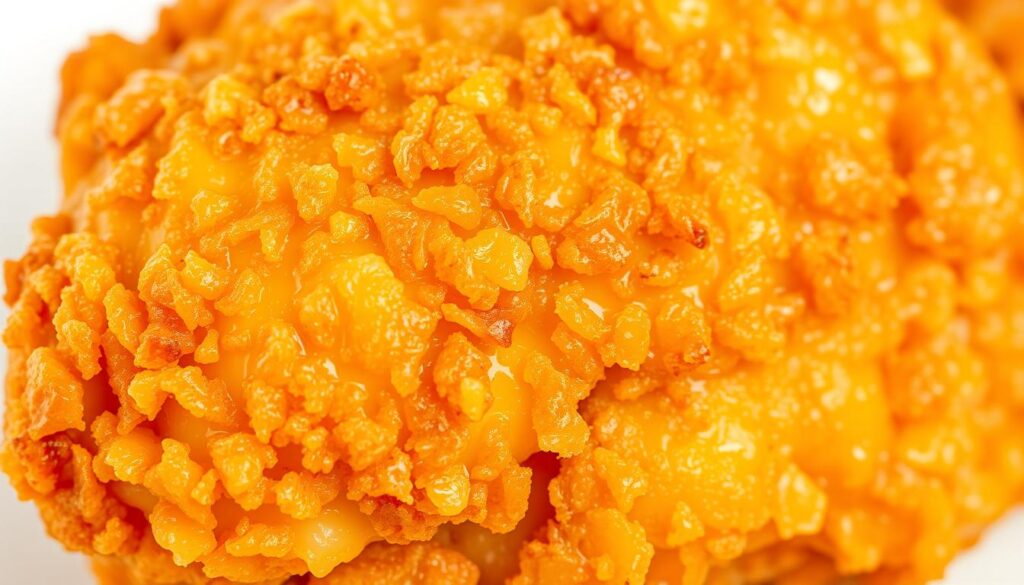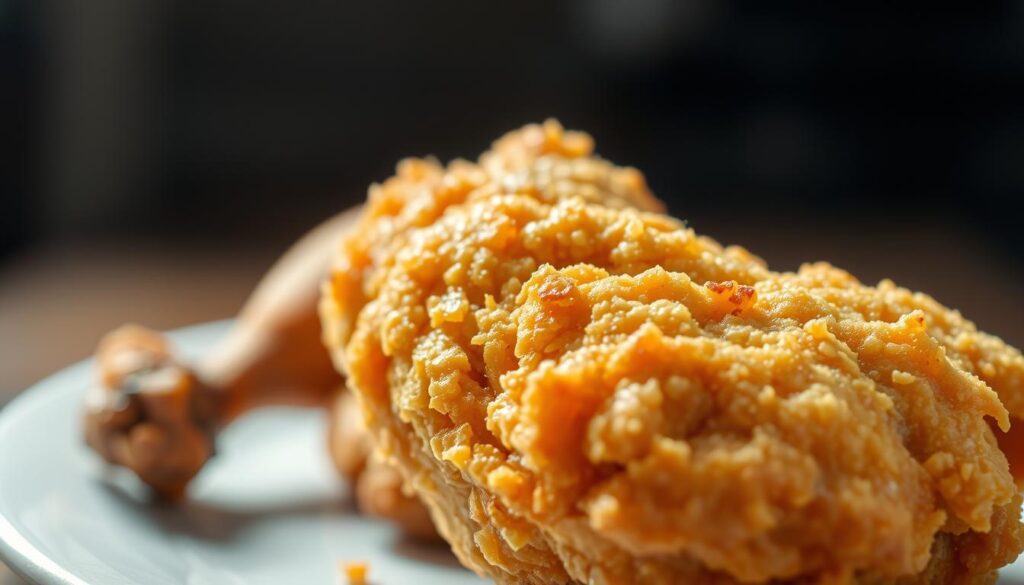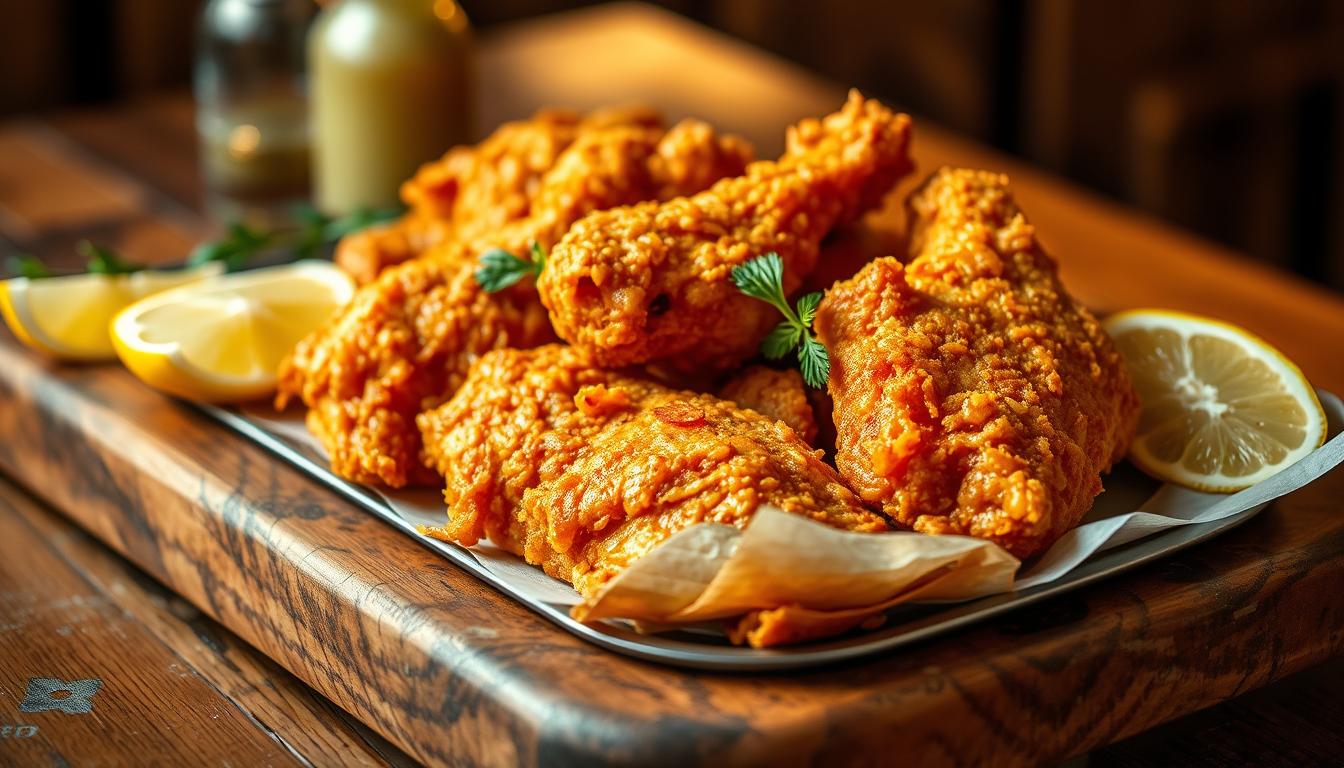The sizzle of hot oil, the golden-brown crispy exterior, the tender meat inside – there’s something magical about a perfect crispy fried chicken recipe. It brings people together. Growing up in a Southern kitchen, I learned that creating restaurant-quality fried chicken is an art form. It’s passed down through generations.
You’re about to unlock the ultimate secrets to making a fried chicken recipe that will transform your home cooking. Whether you’re a weekend warrior in the kitchen or someone who’s never deep-fried anything before, these 11 tricks will help you master the perfect crispy fried chicken recipe. It’ll have your family and friends begging for more.
Forget bland, soggy chicken – we’re diving into techniques that guarantee maximum crunch, incredible flavor, and that restaurant-quality texture you’ve always dreamed of creating. Every tip is designed to elevate your cooking skills. It turns an ordinary meal into an extraordinary culinary experience.
Get ready to become the fried chicken champion of your kitchen. Your journey to crispy, golden perfection starts right here.
Table of Contents
The Secret to Restaurant-Style Crispy Fried Chicken

Making the perfect fried chicken is more than just mixing ingredients. It’s a mix of science, skill, and love. Whether you want to make a KFC-style chicken at home or create your own, knowing the basics is key.
Understanding the Science of Crunch
The secret to that crispy restaurant-style chicken is in the science. When you make fried chicken, you’re working with proteins, moisture, and a coating. These elements interact in a complex way.
- Protein structure breaks down during marination
- Moisture gets sealed within the meat
- Coating creates a protective crispy barrier
Why Temperature Control Matters
Temperature is not just a number; it’s crucial for great fried chicken. Chefs use precise heat to control texture, flavor, and quality.
Consistent oil temperature ensures even cooking and maximum crispiness.
The Role of Buttermilk in Tenderizing
Buttermilk does more than just marinate—it tenderizes. Its acidity breaks down proteins, keeping your chicken juicy and tender.
- Softens meat fibers
- Adds subtle tangy flavor
- Helps coating adhere better
By learning these techniques, you can turn your fried chicken into gourmet food.
Essential Ingredients for Perfect Fried Chicken Recipe

Starting an amazing fried chicken recipe without buttermilk means picking the right ingredients. Success comes from using top-notch parts that make the dish crispy and flavorful.
For your fried chicken recipe without buttermilk, you’ll need a few key ingredients:
- Chicken pieces (4 pounds of mixed cuts)
- All-purpose flour
- Seasonings
- Cooking oil
Choose a mix of chicken pieces like drumsticks, thighs, and breasts. These cuts offer different textures and tastes. Bone-in chicken is usually more moist and flavorful than boneless.
Your flour mix is key for a crispy coating. Make a seasoned flour blend with:
- Salt
- Black pepper
- Paprika
- Garlic powder
- Cayenne pepper (optional for heat)
If you can’t use buttermilk, try a milk and vinegar mix or yogurt. These alternatives tenderize the chicken and add a tangy taste.
Pro tip: Choose a neutral oil with a high smoke point like vegetable or canola oil for the best frying results.
Each ingredient is crucial for a tasty fried chicken dish. It will surely wow your family and friends.
The Ultimate Double-Coating Technique
To get that restaurant-quality crunch, you need more than just hot oil. The secret is a precise double-coating method. It turns ordinary chicken into a crispy masterpiece.

Professional chefs say the breading process is key for the perfect KFC crispy fried chicken. Your coating technique decides between a soggy mess or a crispy delight.
First Layer: Seasoned Flour Mixture
Your first layer is the base of crispiness. Make a seasoned flour mixture. It helps the coating stick and adds flavor. Here’s what you’ll need:
- All-purpose flour
- Salt
- Black pepper
- Paprika
- Garlic powder
Second Layer: Creating the Perfect Crust
After the flour coating, dip your chicken in an egg wash, then coat with seasoned breadcrumbs. Press the breading firmly to ensure maximum adhesion and crunch.
Resting Period: Why It’s Critical
The most overlooked step is the resting period. Let your breaded chicken sit for 5-10 minutes before frying. This lets the coating set, so it doesn’t fall off during cooking.
Pro tip: Use one hand for dry ingredients and another for wet to keep your breading station clean and efficient.
Mastering the Oil Temperature
Getting the perfect deep fried chicken recipe needs precision, mainly with oil temperature. The right temperature makes all the difference. It can turn your meal into crispy, golden goodness or a greasy mess.
Temperature control is key for that perfect crunch in your fried chicken. The ideal frying temperature is between 350-365°F. If your oil is too hot or too cold, you’ll face several problems:
- Too hot oil burns the outside and leaves the inside raw
- Too cool oil makes the chicken soggy and oily
- Uneven temperatures cause uneven cooking
To perfect your fried chicken, get a good deep-fry thermometer. It’s your kitchen’s best friend, helping keep the oil at the right temperature.
Here are some tips for managing oil temperature:
- Preheat your oil slowly and steadily
- Let oil recover temperature between batches
- Don’t overcrowd the fryer – give each piece space
- Use oils with high smoke points like peanut or canola
Pro tip: When you add chicken to the oil, the temperature will drop. Be ready to adjust your heat to keep it at 350-365°F.
Patience and attention to detail are key to creating restaurant-quality fried chicken at home.
Seasoning Secrets for Maximum Flavor
Turning a simple fried chicken recipe into a masterpiece is all about seasoning. The right spice blend can take a basic dish to new heights. It adds layers of flavor that will make your taste buds sing.
Creating unforgettable fried chicken starts with knowing how herbs and spices work together. Your seasoning strategy should be careful and thoughtful.
Crafting the Perfect Spice Blend
When making your fried chicken, remember these key seasonings:
- Paprika: Gives a rich color and smoky taste
- Garlic powder for a strong aroma
- Cayenne pepper for a hint of heat
- Dried herbs like thyme or oregano
Balancing Salt and Aromatics
Salt is essential in fried chicken, but use it sparingly. Too little makes it taste bland, while too much hides the chicken’s natural flavor. Kosher salt is best for even flavor.
Pro tip: Season your chicken in layers – during marination, in the flour coating, and with a final sprinkle after frying.
Try different spice mixes to make a fried chicken recipe that’s all your own. The right blend will have your guests coming back for more.
The Two-Stage Frying Method
Want to make your fried chicken breast recipe better? Learn the two-stage frying method. It’s a secret used by chefs to make chicken crispy and juicy.
This method splits frying into two parts. You aim for a golden-brown outside and tender, fully cooked chicken.
- Stage 1: High-Temperature Initial Fry
- Quickly brown the chicken’s exterior
- Create a crisp initial coating
- Lock in initial flavor
- Stage 2: Low-Temperature Cooking
- Reduce heat to cook chicken thoroughly
- Prevent burning or excessive browning
- Maintain moisture inside the meat
- To start, heat oil to about 350°F for the first stage. Fry your chicken pieces for 2-3 minutes until they’re golden. Then, lower the heat to 300°F and cook for 10-12 more minutes.
Pro tip: Use a meat thermometer to ensure your chicken reaches an internal temperature of 165°F for safe consumption.
- Finish by raising the heat to crisp the outside. This gives your fried chicken that irresistible crunch.
Achieving Golden-Brown Perfection
To make the ultimate crispy fried chicken, you need to get the visual and temperature right. You want your chicken to be golden brown on the outside and juicy inside.
Getting your fried chicken just right is more than cooking. It’s about knowing when it’s done.
Visual Cues for Doneness
Here are the visual signs to look for:
- Deep golden-brown exterior with a consistent color
- Crispy, textured coating that appears evenly crunchy
- Oil bubbles that have slowed down significantly
- No visible raw or pale spots on the chicken’s surface
Internal Temperature Verification
While visual cues are good, a meat thermometer is best. Always check the chicken’s internal temperature for safety.
“The secret to perfect chicken is hitting that magic 165°F mark every single time.” – Professional Chef
- Insert meat thermometer into thickest part of chicken
- Ensure temperature reaches 165°F
- Remove chicken from oil immediately after reaching temperature
Pro tip: Let your fried chicken rest for a few minutes after cooking. This helps keep it crispy and allows juices to spread evenly.
Proper Draining and Resting Techniques
After making your easy fried chicken recipe, the last steps are key. They help keep the chicken crunchy and flavorful. Draining and resting correctly can make your dish stand out.
Forget about paper towels. A wire rack is the best tool for crispy fried chicken. It lets excess oil drip off while keeping the chicken crunchy. Put the wire rack over a baking sheet to catch any drips.
- Let chicken rest for 5-10 minutes after frying
- Use a wire rack instead of paper towels
- Allow natural cooling to redistribute juices
“The difference between good and great fried chicken is in the resting process.” – Professional Chef
Temperature control is important in your fried chicken recipe. Let the chicken cool to room temperature before storing. This stops moisture from making the coating soggy.
For leftovers, use an airtight container and refrigerate within two hours of cooking. Your fried chicken will stay fresh for up to four days if stored right.
- Cool chicken completely before storing
- Use shallow airtight containers
- Refrigerate within two hours
Pro tip: To reheat, use an oven at 375°F. This keeps it crispy and prevents it from getting soggy.
Storage and Reheating Guidelines
Keeping your homemade kfc fried chicken recipe crispy is key. Proper storage and reheating are crucial. They can turn a delicious meal into a soggy mess.
- Refrigerate within 2 hours of cooking
- Use an airtight container to prevent moisture
- Store in the refrigerator for up to 4 days
- Keep chicken pieces separate to maintain crispiness
Maintaining Crispiness After Cooking
Keeping your fried chicken crispy is all about how you store and reheat it. Never seal hot chicken right away. This traps steam and ruins the crunchy coating.
Best Practices for Leftovers
Reheating your fried chicken needs patience and the right method:
- Preheat the oven to 350°F
- Place chicken on a wire rack
- Bake for 10-15 minutes
- Use the broiler for the last 2-3 minutes to restore crispiness
“The secret to great leftover fried chicken is treating it like a fresh batch!” – Professional Chef
Avoid microwaving, as it makes the coating soggy. Freeze extra chicken for up to 3 months. Wrap each piece in freezer paper or plastic wrap before storing in a sealed container.
Troubleshooting Common Crunchy Coating Issues
Making the perfect fried chicken without buttermilk can be tough. Even skilled cooks face problems that ruin a meal. Let’s look at common issues and how to fix them for that crispy, restaurant-style coating.
Breading Fall-Off Prevention
Many cooks struggle with breading that falls off the chicken. Here are some tips to keep your coating on:
- Pat chicken dry before coating
- Let it sit between coating steps
- Press coating firmly onto the chicken
- Don’t skip the flour dredge
- Keep oil temperature high
Solving Uneven Cooking Challenges
Even cooking is key for great fried chicken. Here’s how to get it right:
- Cut chicken pieces the same size
- Use a meat thermometer
- Keep oil temperature steady
- Avoid overcrowding the pan
- Rotate pieces while frying
Preventing Soggy Coating Disasters
No one likes soggy fried chicken. Here are some ways to keep it crispy:
- Double-bread for extra crunch
- Use fresh, clean oil
- Drain on a wire rack, not paper towels
- Serve right after cooking
- Keep warm in a low oven if needed
With these tips, your fried chicken will go from a possible mess to a crispy, golden masterpiece. It will impress anyone.
Conclusion
Learning to make delicious fried chicken takes time, patience, and practice. You now know the key techniques to make a great meal. From choosing the best ingredients to getting the coating just right, every step is important.
Being good at fried chicken is more than just following a recipe. It’s about getting better with each try, learning about temperature, and trying new seasonings. Your skills will make your fried chicken a hit with everyone.
Great cooking is like art. Every time you make fried chicken, you’ll find new ways to improve. Feel free to change seasonings, try different coatings, or play with oil temperatures. Your confidence will grow with each dish.
The most important thing in fried chicken is passion. Cook with excitement, creativity, and a love for learning. With what you’ve learned, you’re ready to become a fried chicken master in your kitchen.

